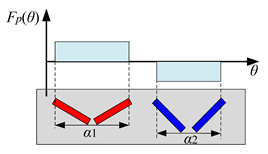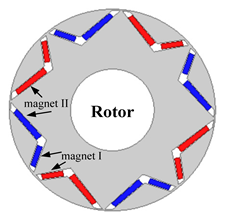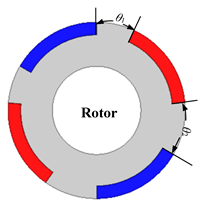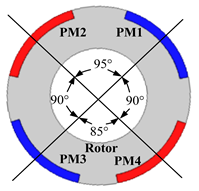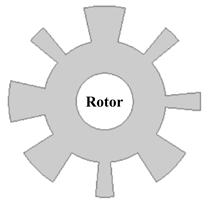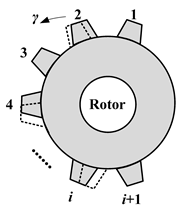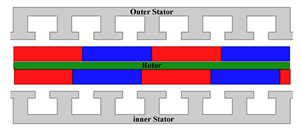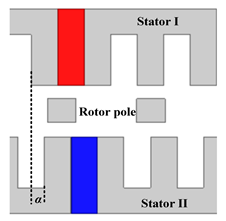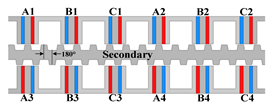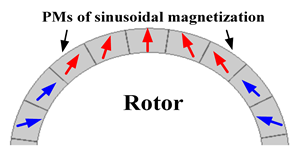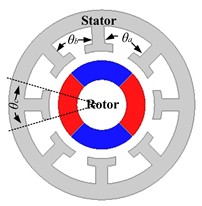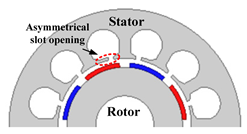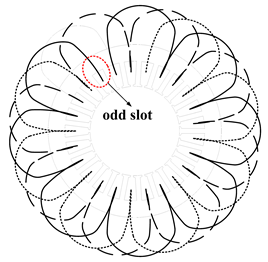Abstract
Permanent magnet (PM) machines inevitably suffer from cogging force, which does not contribute to the average output torque (force) but contributes as a type of torque (force) ripple. This paper provides an overview of the cogging force reduction methods for different types of PM machines. First, a systematic and comprehensive categorization of different kinds of cogging force reduction methods is given according to the reduction principle. Then, the cogging force reduction methods for different types of PM machines are analyzed and discussed based on the categorization. Finally, according to the versatility and feasibility of the cogging force reduction methods, practical methods are recommended for different types of PM machines. The categorization, analyses, and recommendations presented in the paper are useful for the design of different types of PM machines with the requirement of cogging force reduction or output torque (force) ripple suppression.
1. Introduction
Permanent magnet (PM) machines are becoming more common in industrial applications because they can provide high efficiency and high power density, and they are smaller than conventional machines. Moreover, as their cost continues to decrease, they will become an increasingly dominant force in today’s market [1,2,3]. In terms of different forms of motion, PM machines can be divided into rotary PM machines and linear PM machines. Furthermore, PM machines can also be classified based on the placement of the PMs, i.e., conventional PM machines have PMs on the rotor (secondary in linear machines) and stator PM machines have PMs on the stator (primary in linear machines). Although these PM machines have different structures, they share one major drawback: the cogging force (in the form of cogging torque in rotary PM machines).
The cogging force consists of a slot-effect component and an end-effect component. The slot-effect component of the cogging force is the interaction between the PMs and the slots [4]. The slot-effect component of the cogging force exists in both rotary and linear PM machines, while the end-effect component only exists in liner PM machines, owing to the finite length of the armature. The cogging force is inherent to the design of PM machines. It causes force (torque) ripples and may lead to mechanical vibration, acoustic noise, and problems in driven systems [5,6]. Therefore, minimizing the cogging force is of great importance in the design of PM machines.
The cogging force reduction methods for different types of PM machines have been widely investigated, and reviews of these methods are available in the literature [7,8,9,10,11,12]. Early overviews of the cogging torque in PM machines were published in Refs. [7,8]. In Ref. [7], any unwanted torque variations in terms of position, i.e., due to variations in the air-gap geometry, or reluctance in the iron circuit, are regarded as cogging torques. In Ref. [8], various cogging torque minimization techniques are analyzed as applied to a rotary surface-mounted permanent magnet (SPM) machine. The authors in [9] also describe various classical and innovative methods for cogging torque reduction in rotary SPM motors and give theoretical justification for each of them. In addition, the influence of cogging torque reduction on back electromotive forces (EMFs) are also analyzed, something that has been researched extensively. In Ref. [10], several cogging torque suppression techniques for a rotary internal permanent-magnet (IPM) machine, such as skewing, design of the arc/pitch ratio, and dummy slots and notches in stator or rotor machines, are compared to find the most effective examples. Moreover, an assessment of the feasibility of different techniques for IPM machines is also given. Different types of thrust ripple/cogging force suppression methods for linear PM machines are summarized and their principles are analyzed in [11], including structural optimization methods, control methods, and a combination of structural design and control methods. In Ref. [12], several cost-effective PM skewing methods to reduce the cogging torque in double-rotor axial flux PM motors are assessed. The paper also summarizes techniques of reducing cogging torque for both stator and rotor PM machines, and various methods were verified using 3D finite-element analysis (FEA) and experiments. For stator PM machines, such as flux switching permanent magnet (FSPM) machines, methods based on modifications of the rotor were analyzed and studied, and methods combined with optimal stator tooth width were also introduced [13]. The methods introduced in [13] are practical and can be extended to other stator PM machines.
However, the reviews of cogging force reduction methods in the current literature have the following shortcomings:
- (1)
- They do not provide a systematic and comprehensive classification of different methods;
- (2)
- Most reviews on cogging force (torque) reduction methods focus on one type of PM machine, and there are few studies that compare different types of PM machines;
- (3)
- The versatility and feasibility of different methods applied to different PM machines are not comprehensively analyzed.
Therefore, the purpose of this paper is as follows:
- (1)
- To provide a systematic and comprehensive categorization of different kinds of methods for reducing cogging force according to different principles, as shown in Figure 1;
 Figure 1. Categorization of cogging force reduction methods for PM machines.
Figure 1. Categorization of cogging force reduction methods for PM machines. - (2)
- To analyze and summarize the main cogging force reduction methods for both rotary and linear PM machines, based on Figure 1.
It should be mentioned that linear PM machines have more design flexibility than their corresponding rotary counterparts due to there being more space, as shown in Figure 2. Therefore, methods that cannot be used for rotary PM machines but can be used for linear PM machines are also discussed in this paper.
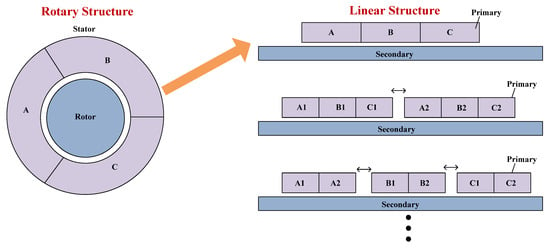
Figure 2.
Design flexibility of linear PM machines.
- (3)
- To recommend different methods for different types of PM machines according to the versatility and feasibility of these methods.
2. Reduction Methods of Slot-Effect Component
Both rotary and linear PM machines have the slot-effect cogging force, and the principles of the reduction methods are the same.
Taking the conventional rotary PM machine as an example, the cogging torque can be expressed as [14]:
where Φδ is the air gap flux, R is the air gap reluctance, and θ is the rotor angular position. The cogging torque exhibits periodical features because the air gap reluctance is periodical. Thereby, a Fourier series of the cogging torque can be obtained as [14]:
where m is the least common multiple of the number of stator slots (Ns) and the number of poles (Np), k is an integer, and Tmk is a Fourier coefficient.
Figure 3 gives a simple model of the cogging torque mechanism. As can be seen, when the axes of the PM pole align with the center of the teeth or align with the center of the slots, the instantaneous value of the cogging torque is zero. When the PM pole approximately aligns with the edges of the slots, the cogging torque reaches its peak value (negative or positive).
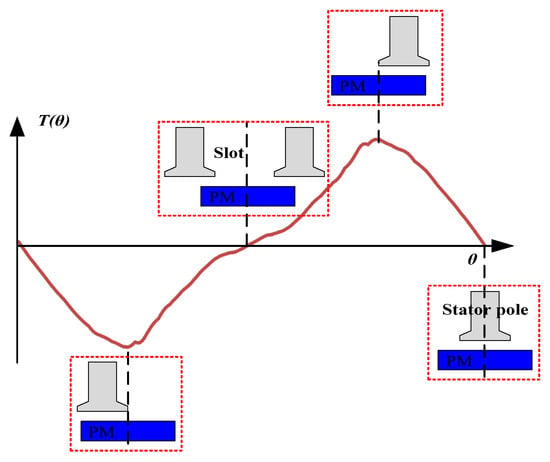
Figure 3.
Simple model of the cogging torque mechanism.
The following conclusions were drawn from the above equations and figures:
- (1)
- The cogging torque is the interaction between the PMs and the slots. It results from an uneven air gap permeance causing the magnets to constantly seek a position of minimum reluctance, and the cogging torque period is directly linked with the number of slots and poles;
- (2)
- The average value of the cogging torque is almost zero. It does not contribute to the average electromagnetic torque, but contributes as torque ripples;
- (3)
- As the cogging torque can be expressed as a summation of harmonic sinusoids and the fundamental flux is necessary for torque production, the reduction methods mainly aim to minimize the main harmonics by reducing the harmonics of either PM magnetomotive force (MMF) or the air gap permanence.
It should be mentioned that the cogging torque of stator PM machines is caused by the interaction of doubly salient stator and rotor structures on the open circuit, and it is larger than that of conventional PM machines [13]; however, the features of their cogging torque are similar to the features of conventional PM machines’ cogging torque [14].
As shown in Figure 1, according to the different ways of modifying the machine structure, this paper categorizes slot-effect cogging force reduction methods into two groups: reduction methods based on changing the cross-sectional structure of the machine (an example is given in Figure 4a [10]) and reduction methods based on changing the axial structure of the machine (an example is given in Figure 4b) [15].
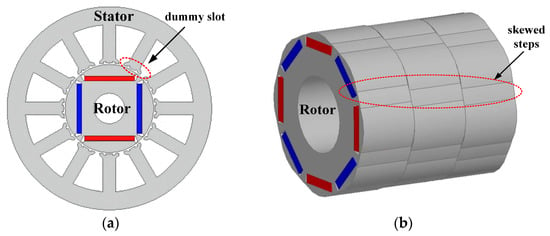
Figure 4.
Examples of the reduction methods based on changing the cross-sectional structure of the machine and reduction methods based on changing the axial structure of the machine, respectively: (a) an example of reduction methods based on changing the geometry of machine laminates, e.g., a dummy slot (modified from [10]); (b) an example of reduction methods based on a multi-segment structure, e.g., a step-skewed rotor (modified from [15]).
2.1. Reduction Methods Based on Changing the Cross-Sectional Structure of the Machine Lamination
The cross-sectional structure of stator or rotor lamination of PM machines using this kind of cogging force reduction technique is modified as compared with that of the original machines. In this paper, the geometric parameter design and the asymmetrical arrangement are regarded as belonging to this group.
2.1.1. A. Geometric Parameter Design
Since the main source of the cogging force is the interaction between the PMs and the slots, slot openings, the pole-arc ratio, and PM/iron shape have a great influence on the cogging force. Hence, geometric parameter design methods always reduce the slot-effect cogging force by optimizing the above geometric parameters, which is analyzed in the following sections.
A-I. Design of the Slot Opening
In this section, slot opening design methods are discussed, including the design of the slot opening size [4,16,17], the closed slot structure [18], and the slotless structure [19].
In Ref. [4], for an SPM generator, three different slot openings, i.e., 2, 4, and 6 mm, are compared to show the difference in the change in cogging torque. It was found that the cogging torque decreases as the slot opening becomes smaller; however, from the manufacturing point of view, it is not convenient to install the winding through the slot opening as it is too small. Moreover, it was revealed in Ref. [16] that the optimum slot opening value may not always be acceptable since it may be too small or too large.
The authors in Ref. [17] provide a general method for predicting the cogging torque in SPM machines. The influence of imperfect slot openings on the cogging torque is analyzed using a subdomain model. It showed that machines with more options of optimal slot opening widths for cogging torque minimization are more sensitive to manufacture tolerance related to slot opening.
In fact, the closed slot structure for PM machines can minimize or eliminate the cogging torque [18]. The structure can be realized through the manufacturing process, for example, by assembling the PM machine stators with the windings from the back and fixing the yoke in the last step or winding the stator tooth segments in advance before assembly.
In addition, the slotless structure can be regarded as a special slot structure design, as shown in Figure 5 [19]. This structure eliminates slotting and provides various benefits: (1) smooth operation and low noise with zero slot-effect cogging torque; (2) easy heat radiation from the coil located at the air gap; (3) good performance at small sizes and high speeds [20]. However, the drawbacks are also obvious: a low intrinsic torque density because of the low magnetic flux density in the stator coils.
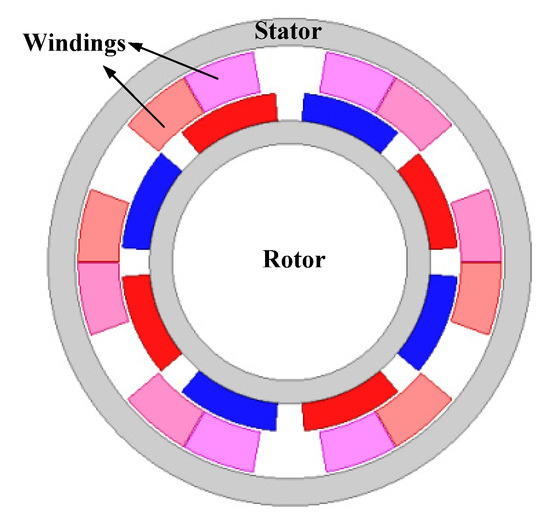
Figure 5.
A slotless PM machine (modified from [19]).
Generally, it is a trade-off between cost and performance because the selection of slot opening affects the manufacturing cost. Furthermore, the optimal slot opening width can reduce the cogging torque and the torque ripple, but it can also decrease the average torque [10].
A-II. Design of the Pole-Arc Ratio
For a fixed pole pitch, the PM pole arc can be designed to reduce or eliminate some cogging torque harmonics [9]. There exists an optimum pole arc value that minimizes cogging torque, which seems to be slightly larger than k (an integer) times the slot pitch [9,10,14]. The cogging torque can be significantly suppressed by selecting a proper pole-arc ratio. Here, the relationships between the pole-arc coefficient and the cogging torque [21], the optimal pole-arc ratio for minimum cogging torque [22], the pole arc-ratio for stator PM machines [23], and the sensitivity of the pole-arc ratio to the cogging force are discussed.
The authors in Ref. [9] find that the cogging torque may be simply considered as the sum of the interactions of each edge of the PMs with the slot openings, as shown in Figure 3. Thus, the study of the cogging torque can be simplified to the analysis of one of these interactions, considering each of them independently from the others. A useful model for cogging torque analysis is also presented and it was found that the cogging torque can be greatly reduced if the PM spans almost an integer number of slot pitches. In Ref. [21], the relationship between the pole-arc coefficient and the cogging torque for a SPM motor is established based on an analytical method. Then, the most feasible region of the pole-arc coefficient is derived, and the cogging torque is reduced after optimization.
The cogging torque of a four-pole IPM machine is studied in Ref. [22]. Therein, the optimal ratio for the minimum cogging torque can be obtained by appropriately defining an effective pole-arc-to-pole-pitch ratio (as seen in Figure 6).
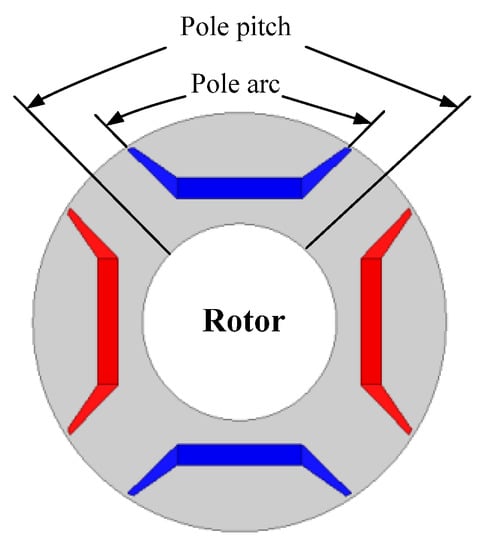
Figure 6.
Definition of pole-arc-to-pole-pitch ratio for the IPM machine (modified from [22]).
For stator PM machines, the design of the rotor pole (tooth) arc also greatly affects the cogging torque. In Ref. [23], for an axial flux flux-switching permanent magnet (FSPM) machine, the rotor tooth is shaped in different ways, and the effect of rotor tooth shaping on the cogging torque is analyzed. It is revealed that, for each of the shaped rotor teeth, a proper rotor tooth arc can be chosen to achieve a relatively small peak-to-peak (p-p) cogging torque. The authors in Ref. [24] study the influence of various leading design parameters on the thrust force performance of a linear FSPM (LFSPM) machine. One of the key parameters is the ratio of the secondary tooth width to primary pole pitch. It was found that, for a fixed primary pole pitch, the cogging force of the LFSPM machine is sensitive to the secondary tooth width, and a proper width can be obtained by considering both the average thrust force and the cogging force.
However, the cogging force is sensitive to the pole-arc ratio, and it is difficult to establish the optimal pole-arc width. The FEA is always used to optimize the pole-arc coefficient, and changes to the pole-arc coefficient should be very small due to the abovementioned sensitivity [24].
A-III. Design of the PM/iron Shape
In this section, we discuss different ways in which to modify the PM shape or iron shape for cogging force reduction (see [9,10,22,23,25,26,27,28,29,30,31,32,33,34,35,36,37,38,39,40,41,42]). These include:
- (i)
- PM shaping for SPM machines, such as slotting in the PM edge [25] and sinusoidal shaping of PMs [30,31,32];
- (ii)
- Different PM pole structures for IPM machines [22,29];
- (iii)
- Cutting or slotting the iron of the rotor (secondary) for IPM machines [10,26,27,28];
- (iv)
- Rotor (secondary) pole shaping for stator (primary) PM machines [23,33,34,35,36];
- (v)
- Dummy slots or notching [9,10,37,38,39,40,41,42].
Examples of the above-mentioned methods are shown in Figure 7.
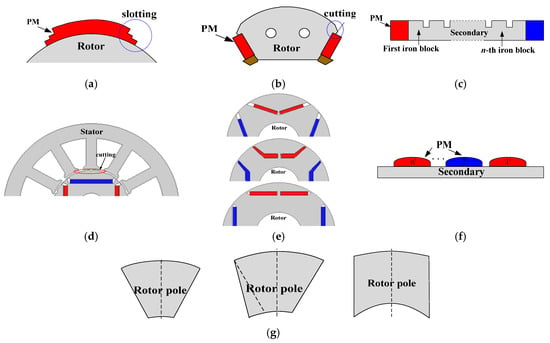
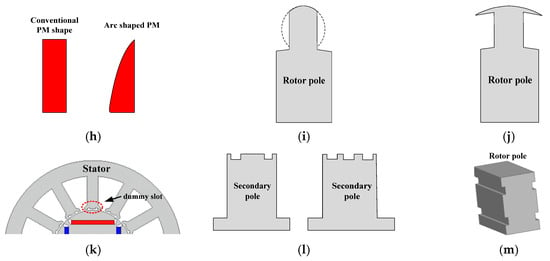
Figure 7.
Examples of the design of the PM shape or iron shape: (a) slotting at the PM edge for SPM machines (modified from [25]); (b) cutting at the ends of the rotor iron for IPM machines(modified from [26]); (c) slotting in the iron of the secondary tooth for linear IPM machines (modified from [28]); (d) cutting in the iron of the rotor for IPM machines (modified from [10]); (e) different PM pole structures (‘U’-shaped and ‘─’-shaped) for IPM machines (modified from [29]); (f) sinusoidal shaping of PMs for SPM machines (modified from [31]); (g) cross sections of different rotor pole shapes for axial flux FSPM machines (modified from [23]); (h) arc-shaped triangular PMs for axial flux FSPM machines (modified from [33]); (i) arc-shaped rotor pole for FSPM machines (modified from [35]); (j) rotor pole flange for FSPM machines (modified from [36]); (k) dummy slots for the stator (modified from [10]); (l) secondary notching for FSPM machines (modified from [40]); (m) rotor notching for axial flux FSPM machines (modified from [42]).
PM shaping methods for SPM machines exhibit good results in terms of cogging force reduction due to the improvement of harmonics either in the PM MMF or in the air gap permeance; however, they may cause a flux decrease and sometimes the PM volume needs to be increased. Therefore, it is relevant to evaluate the reduction effect of these methods under the same PM volume or compare the ratio of the p-p cogging torque to the average torque. Unlike SPM machines, for which there are many ways to shape the PMs, the modifications of PM poles for IPM machines are limited and focus specifically on the PM pole structures. Different PM pole structures mainly affect the pole-arc ratio, and then affect the cogging torque [22].
Iron cutting methods like cutting or slotting the iron of the rotor (secondary) mainly aim at improving the harmonics of the air gap permeance, thus reducing the cogging force harmonics.
There are not many ways to change the shape of PMs due to the stator geometry in stator (primary) PM machines. The arc-shaped triangular PMs for axial flux FSPM machines in [33] are not practical for FSPM machines because they complicate the manufacturing process, and the torque performance is negatively affected. A cogging torque reduction method based on the design of a small space gap between the two adjacent magnets was presented for a flux-reversal PM machine. It is effective for cogging force reduction; however, this method is not applicable to other stator (primary) PM machines [43]. On the other hand, the methods involving the shaping of the rotor (secondary) pole are commonly used for stator (primary) PM machines [34,35,36], and these methods can improve the air gap permeance vibration, thus decreasing the cogging force.
The slot and pole number combination has a great influence on the cogging force. Dummy slot (notching) methods modify the slot number and pole number combination and can be used on different types of PM machines. It was found that the purpose of dummy slots is to increase the number of interactions between PMs and slots, thus increasing the cogging torque fundamental frequency and reducing the peak value of the cogging torque at the same time. Since these methods increase the cogging torque fundamental frequency, they can produce satisfactory results with a small number of slots per pole; however, for a large number of slots per pole, they lead to unnecessarily complex stator/rotor geometries without any significant improvements.
2.1.2. B. Asymmetrical Arrangement
Asymmetrical arrangement methods are based on the concept of harmonic cancellation. In this paper, the following groups of cogging reduction techniques fall into the category of ‘Asymmetrical arrangement’.
B-I. Asymmetrical Arrangement of the Poles or Slots
Taking conventional rotary PM machine integral pitch windings as an example, the cogging torque contribution of each PM is [14]
where TpNsk is a per PM coefficient. In PM machines, the cogging torque of PM machines exhibits an ‘additive effect’ because each PM has the same relative position with respect to the slots. The elementary cogging torque from each PM is in phase with the others, and thus the harmonic components of each are added. Therefore, if the elementary cogging torques from the PMs are out of phase with each other, such as when there is an asymmetrical arrangement of the rotor (secondary) poles or slots, the above ‘additive effect’ becomes a ‘subtractive effect’. This causes some of the harmonics of the cogging force to be canceled. The discussion of the methods based on an asymmetrical arrangement of the rotor (secondary) poles or slots is given in Table 1. In Table 1, the asymmetrical V-type PM arrangement for IPM machines [29,44], PM or rotor (secondary) pole shifting [9,13,14,40,45,46,47,48,49,50,51,52], stator or rotor shifting for double-sided PM machines [50,51,52,53,54,55], Halbach sinusoidal magnetization for SPM machines [56], asymmetrical slot opening [57,58], and an additional slot structure [59] are discussed with emphasis on the classification of different methods and the influence of asymmetrical structure on the cogging force reduction and the machine performance. Besides, the example structures are referred from the above references, but modified for a clear illustration.

Table 1.
Asymmetrical arrangement of the poles or slots.
B-II. Shifting of Primary Modules for Linear PM Machines
It was reported in a previous discussion that the rotary PM machines always adopt rotor pole shifting because slot shifting is not practical. However, slot shifting methods are relatively easy to realize on linear PM machines. As can be seen in Figure 2, for linear PM machines with short primary and long secondary poles, the primary pole has more space than in corresponding rotary machines, leading to a more flexible design of the primary pole [60,61,62,63,64,65,66]. Therefore, in addition to the aforementioned cogging force reduction methods, more methods can be obtained based on the modification of the primary pole. Here, the reduction methods based on the shifting of the primary modules are discussed, including primary modules shifted by an adjustable flux barrier in a linear IPM machine [60], an ‘ABC-ABC’ primary structure in a modular linear FSPM machine [61], primary modules shifted by two flux barriers in a linear vernier PM machine [62], a ‘2A2B2C’ primary structure in a modular linear FSPM machine [63], a pseudo-six-phase primary structure using flux barriers in a linear FSPM machine [64], and primary modules shifted by an adjustable iron in a tubular linear FSPM machine [65], as shown in Figure 8.
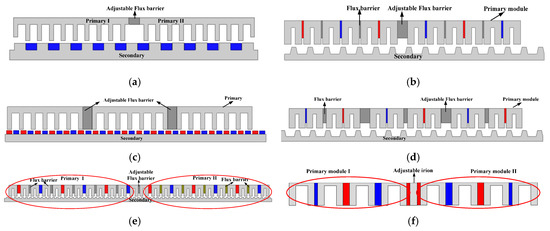
Figure 8.
Shifting of primary modules: (a) primary modules shifted by an adjustable flux barrier in a linear IPM machine (modified from [60]), (b) an ‘ABC-ABC’ primary structure in a modular linear FSPM machine (modified from [61]); (c) primary modules shifted by two flux barriers in a linear vernier PM machine (modified from [62]); (d) a ‘2A2B2C’ primary structure in a modular linear FSPM machine (modified from [63]); (e) a pseudo-six-phase primary structure using flux barriers in a linear FSPM machine (modified from [64]); (f) primary modules shifted by an adjustable iron in a tubular linear FSPM machine (modified from [65]).
As can be seen in Figure 8, the primary structures of these machines consist of primary modules and flux barriers, and the flux barriers divide the primary modules into several groups. The cogging force of each group can be regarded as an elementary cogging force; therefore, the machine cogging force is the sum of the elementary cogging forces. Thus, the harmonic cancellation approach is used to reduce the machine cogging force by appropriately designing the width of the flux barriers to generate a phase angle difference in each group. For example, in Ref. [64] the phase angle difference of Part I and Part II is 30° (the electrical degree), resulting in the controlling of the width of the flux barrier between Part I and Part II, while the phase angle difference of the two adjacent modules in Part I or Part II is 60° (the electrical degree). As compared with the conventional structure, this structure cancels the main harmonics of the cogging force, and, at the same time, the back EMFs become more sinusoidal.
It should be mentioned that the modular FSPM machines in Refs. [61,63] have two types of flux barriers: the thinner ones are used as the flux barriers for the modular structure, and the thicker one is used for the reduction of both the back-EMF harmonics and cogging force.
In linear PM machines, there exists the end effect of the cogging force, which is influenced by the primary length. Therefore, the width optimization of the flux barriers considers the reduction effect of the whole cogging force, including the slot-effect and the end effect.
2.2. Reduction Methods Based on Changing the Axial Structure of the Machine
The methods discussed in Section 2.1 change the cross-sectional structure of the original machine lamination, including the geometric parameters, ratios, and the cross-sectional structure. Some of these changes either affect the electromagnetic performance or constrain the structural improvement.
In this section, we discuss the methods that change the axial structure rather than the cross-sectional structure of the original machine lamination, i.e., cogging force reduction methods based on asymmetrical arrangement in the stack. These methods are also based on harmonic cancellation.
2.2.1. A. Skewing Structure
Skewing may be accomplished with either a skewed stator (primary) or a skewed rotor (secondary), which have the same effect [16,67,68,69,70,71,72,73,74,75,76,77,78,79,80,81,82,83,84]. Typical structures are given in Figure 9.
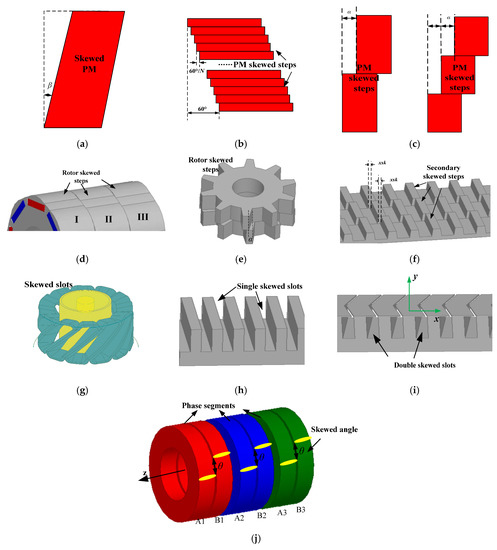
Figure 9.
Typical skewing structures: (a) traditional skewed rotor for SPM machines (modified from [67]); (b) multiple N-slice (step) skewed rotor for SPM machines (modified from [73]); (c) two- and three-stepped skewed rotor for SPM machines (modified from [75]); (d) three-stepped skewed rotor for IPM machines (modified from [15]); (e) two-stepped skewed rotor for FSPM machines (modified from [72]); (f) three-stepped skewed rotor for linear FSPM machines (modified from [77]); (g) traditional skewed stator for PM machines (modified from [76]); (h) single skewed stator for linear SPM machines (modified from [78]); (i) dual skewed stator for linear SPM machines (modified from [78]); (j) stepped (segment) skewed stator transverse flux PM machines (modified from [68]).
A-I. Skewing of Rotor (Secondary)
Taking a skewed rotor of a linear FSPM machine in Ref. [77] as an example, the cogging force can be expressed as
where n is the number of skewed secondary steps in [77], n = 3, and xsk is the skewed displacement of each step. The combination of different n and xsk can be selected to reduce the cogging force.
It was found that the skewed rotor (secondary) can be regarded as consisting of pieces that are shifted with an angle in the stack direction. The pieces can either be rotor (secondary) sheets (traditional skewing) [67,70] or segments (step skewing) [69,71,72,73,74,75,77], as shown in Figure 9a–f. If the rotor (secondary) is not skewed, each piece has the same relative position with respect to the slots. While the rotor (secondary) is skewed, the cogging effects of each piece are out of phase. Therefore, the skewing methods can cause the ‘additive effect’ of the cogging force of each piece in the stack direction to become a ‘subtractive effect’. Therefore, by selecting proper skewed angles and the number of steps (for step skewing), some of the harmonics of the cogging force caused by each piece can be canceled by other pieces, reducing the whole cogging force of the machine. Moreover, step skewing methods of the rotor (secondary) are more practical as compared with traditional skewing considering the manufacturing process.
However, skewing reduces the maximum value of the fundamental back EMF. Figure 10 gives the vector diagram of PM machines with and without a skewed secondary step. Here, θsk is the stepped skewed angle, and and are vectors of the phase no-load back EMF with and without skewing, respectively. As can be seen, the magnitude of the fundamental back EMF is decreased under skewing. The authors in [74] show that the average torque output exhibits a decrease from one to two skewing steps and gradually declines as the rotor skewing step number further increases. The bigger the skewed angle (under constant steps) or the bigger the step number (under a constant skewed angle), the smaller the average torque (force). This is because when the cogging force of each piece under skewing has a ‘subtractive effect’ on the other pieces, the output torque (force) also exhibits a ‘subtractive effect’. For manufacturing convenience, the step number should be as small as possible. Generally, two steps or three steps with an appropriate skewed angle can achieve a satisfactory reduction effect [15,74,75].

Figure 10.
The vector diagrams of PM machines with and without step skewing of the rotor (secondary): (a) three-stepped skewing; (b) two-stepped skewing.
The following two ratios related to skewed angles are recommended in order to select appropriate skewed angles under a fixed number of skewed steps.
- (i)
- The decreasing ratio of the torque (force), , where and Ft are the output torque (force) with and without skewing, respectively;
- (ii)
- The reduction ratio of the p-p cogging force or torque (force) ripple , where and Fp-p are the p-p cogging force or p-p torque (force) ripple with and without skewing, respectively.
Then, proper skewed angles can be selected based on the maximum difference between the two ratios. Examples are shown in Figure 11, where Δt is the decrease ratio of the average thrust force and Δc is the reduction ratio in the p-p cogging force [77].
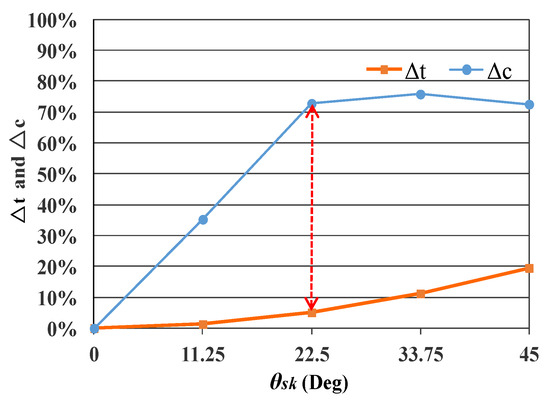
Figure 11.
Example of skewed angle selection [77].
A-II. Skewing of Stator (Primary)
The skewing method can be applied for the stator (primary) [68,76,78], as shown in Figure 9g–i; however, this method is difficult in practice. Laminations have other features cut into them, which requires unique laminations that need to be monitored during the stacking process. Additionally, skewing the stator (primary) reduces the cross-sectional area of the slot by the cosine of the angle of the skew and lengthens the wire in the slot by the inverse of the cosine of the angle, increasing copper losses [67]. Moreover, skewing of the stator (primary) makes automatic slot filling almost impossible. Thus, it cannot be applied to mass production motors [9]. It should be mentioned that, for transverse flux PM machines, stator stepped skewing is practical due to the three phases being arranged in the transverse direction [68], as shown in Figure 9j.
Additionally, for stator (primary) PM machines, such as FSPM machines, stator (primary) skewing is even more difficult to implement because the PMs are located on the stator (primary); however, rotor (secondary) skewing is easier to accomplish owing to the simple structure of the rotor (secondary) without PMs.
2.2.2. B. Segment Structure
The segment structure is proposed to reduce the cogging force and, at the same time, to effectively suppress the harmonics in the back EMF [84,85]. The segment structure of FSPM machines is given in Figure 12, where the rotary segment structure [85] and the linear segment structure [84] are given. As can be seen in Figure 12b, the primary structure consists of two segments of the same size, where the two magnets of the front segment and the back segment are magnetized in opposite directions. The two segments constitute one complete primary pole by sharing one armature winding. Correspondingly, the secondary structure also consists of two segments that are staggered. Both the primary and the secondary structures contain a thin flux barrier to avoid a magnetic short circuit. This structure can cancel the harmonics of both the cogging force and the back EMF; thus, the cogging force and the harmonics of the back EMF can be significantly reduced by selecting a proper staggered angle. As compared with the three-stepped skewing structure, the segment structure exhibits the same cogging force reduction effect and a better reduction effect of the harmonics of the back EMF, especially the second-order harmonic. Moreover, it also has a smaller influence on the average thrust force [77,84]. However, the primary structure is more complex.
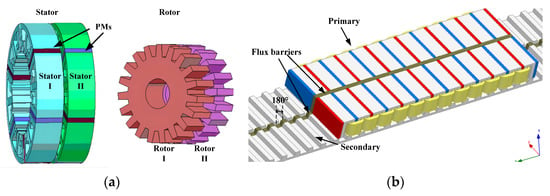
Figure 12.
The segment structure of FSPM machines: (a) rotary structure (modified from [85]); (b) linear structure (modified from [84]).
Additionally, the structure of pole shifting combined with armature arrangement in [54] can be considered as the corresponding double-sided structure of the above segment structure, as shown in Figure 13. As can be seen, the PMs of the upper and lower primary structures are magnetized oppositely, and the upper and lower secondary structures are staggered. This double-sided structure is more practical than the segment structure because it does not require the flux barriers and can reduce the thrust ripple without the average thrust force decreasing.
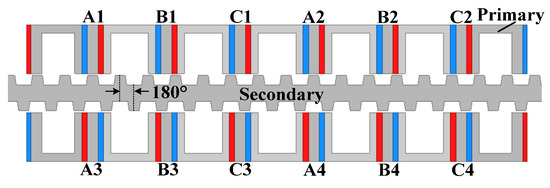
Figure 13.
The double-sided linear FSPM machine with pole shifting (modified from [54]).
3. Reduction Methods of the End-Effect Component
The end-effect component of the cogging force only exists in linear PM machines owing to the finite length of the primary structure. The end-effect component is also periodical and is only related to the length of the primary structure. Thus, the cogging force reduction methods for the end-effect component mainly focus on optimizing the end structure and the overall primary length [86,87,88,89,90,91,92,93,94].
The end assistant teeth and modular structures are used to improve the end flux distribution [60,62,77,84,86,87,88,89,95]. Typical structures of the end assistant teeth are shown in Figure 14a,b. These structures can change the end effect by concentrating the end fluxes in a particular position, thus improving the magnitude of the end flux, as shown in Figure 14c. However, the addition of the assistant teeth affects both the slot-effect component and the end effect of the cogging force because it changes the slot openings at the ends and the length of the primary structure. Hence, two geometric ratios can be used to optimize the assistant teeth for overall cogging force reduction: the assistant-teeth-slot-opening ratio (the ratio of the assistant teeth length to the pole pitch) and the width of the assistant-teeth ratio (the ratio of the assistant teeth width to the pole pitch) [88,90].
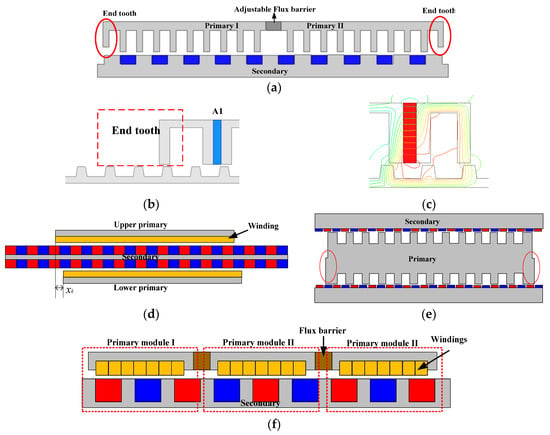
Figure 14.
Typical structures for the cogging force reduction of the end-effect component: (a) assistant teeth in linear PM machines (modified from [62]); (b) assistant teeth in primary PM linear machines (modified from [77,89]); (c) the flux distribution of the end teeth (modified from [87]); (d) staggered primary structures for a slotless double-sided linear PM machine (modified from [92]); (e) unequal end-teeth width for a dual-sided toroidal-winding linear PM machine (modified from [94]); (f) modular slotless structure for a tubular linear PM machine (modified from [66]).
On the basis of a slotless structure, the end-effect cogging force can be regarded as the synthesis of the cogging force of the two ends. Therefore, the optimum length of the primary structure can be deduced based on the analysis of the cogging force waveform developed at one end of the primary structure and the need to develop an opposing cogging force at the other end [91]. Inspired by this, harmonic cancellation approaches can be employed to modify the primary length [66,92,94]. Example structures are shown in Figure 14d–f. As can be seen from Figure 14d,e, both machines take advantage of the double-sided structure. For the slotless machine in Ref. [92], the two primary structures of the same length are staggered by certain a distance, and the amplitudes of the harmonics of the total end cogging force are closely related to the staggered distance. In the linear PM machine in [94], the two sides have an unequal end-teeth width, making the length of the two sides unequal. Thus, some of the end-effect cogging force harmonics can be canceled by optimizing the end-teeth width. The modular slotless structure in Ref. [66] can be regarded as the slotless structure of the PM machine in Ref. [62]; therefore, the end-effect cogging force harmonics can be canceled by adjusting the width of the flux barriers.
It should be mentioned that the methods based on the asymmetrical arrangement in the stack and the shifting of the primary modules can also reduce the end-effect cogging force due to the harmonic cancellation of the total cogging force.
4. Recommendations of Different Methods for Different PM Machines
According to the above analysis, the main advantages and disadvantages of the discussed cogging torque reduction methods are concluded in Table 2.

Table 2.
Discussions of the advantages and disadvantages of cogging torque reduction methods.
On the basis of Table 2, Table 3 shows our recommendations concerning different methods in relation to different PM machines according to their versatility and feasibility.

Table 3.
Recommendations for different PM machines.
From the information in Table 3, the following key points were highlighted.
IPM and SPM machines have the same original stator (primary) structure, so they can employ the same cogging force reduction approaches to modify the stator (primary), such as changing the design of the slot opening, using asymmetrical slot openings or a stator (primary) dummy slot, and shifting the primary modules.
The modification of the rotor (secondary) to suppress the cogging force for both IPM and SPM machines mainly focuses on the shaping of either the PM or the iron. However, the implementation is different due to the different rotor (secondary) structures of the two types of machines. From the manufacturing point of view, the PM shape design method, and the asymmetrical PM arrangement methods for IPM machines are more complicated than for SPM machines because the PMs are buried in the rotor (secondary) core. As a general method, skewing of the rotor (secondary) can be applied to both PM machines, and stepped skewing with a small number of steps is more practical compared with traditional skewing.
For the stator (primary) structure of stator (primary) PM machines, because the PMs are located on the stator (primary), the space for the slot and the size of the stator (primary) pole are restricted. Although the above methods of modifying the stator (primary) can be used for stator (primary) PM machines, the methods using a dummy slot on the stator (primary) and asymmetrical slot openings are not recommended. Similarly, stator (primary) skewing is not recommended either. Moreover, stator (primary) PM machines exhibit a larger cogging force than IPM and SPM machines due to the double salient structure, thus, methods that focus on the design of the rotor (secondary) pole-arc ratio and the rotor (secondary) pole shape may not produce satisfactory effects regarding the cogging force reduction. As a result of the simple rotor (secondary) structure in stator (primary) PM machines, it is recommended to employ methods that modify the rotor (secondary) structure based on harmonic cancellation approaches, such as rotor pole shifting, rotor (secondary) dummy slot, rotor (secondary) stepped skewing, and the segment structure.
For axial flux PM machines, modifications to the stator, such as those that focus on the design of the slot opening and asymmetrical slot openings, are a possibility, but they are not commonly utilized as they complicate the manufacturing process [12]. Modifications to the rotor, such as PM or rotor pole shaping (as shown in Figure 7h), rotor notching (as shown in Figure 7n), and PM or rotor skewing are more practical and cost effective.
For both linear and tubular PM machines, methods focused on shifting the primary modules are very practical because of the flexible design resulting from the increased space on the primary structure. It should be noticed that these methods cannot be used for rotary PM machines due to the space limitations.
Optimizing the end structure is commonly used to reduce the end-effect cogging force of linear PM machines. Moreover, an improved end-teeth structure with end PMs aims at improving the imbalance of the three-phase back EMFs [54,77,89]; however, this is not discussed herein.
The double-sided structure brings design flexibility for cogging force reduction in PM machines, as shown in Table 2. The two sides can be utilized to cancel some of the harmonics of the overall cogging force, including the slot-effect component and the end-effect component.
In addition, other methods that are not listed in Table 3, such as Halbach sinusoidal magnetization [56], additional slots [59], and stator (primary) skewing, are not recommended due to the manufacturing difficulties and low practical value.
5. Other Techniques
The above discussions focus on methods based on structural modifications to reduce the cogging force. However, there are other studies that contribute to cogging force reduction. These are briefly discussed in this section.
A useful analytical expression for the cogging torque is derived on the basis of the energy method and the Fourier series analysis, where the influence of the slot and pole number, the magnet-pole-arc-to-pole-pitch ratio, skewing, and slot opening are all discussed [96]. It was found in [97] that the cogging torque waveform, which is observed in a PM machine, can be synthesized analytically from the cogging torque waveform of a single stator slot. This conclusion is useful, and the synthesis method can be extended to predict the cogging torque waveform in PM brushless machines with nonuniformly distributed stator slots and/or stepped rotor magnets. A calculation method for on-load cogging torque in PM machines is presented in [98]. This method is verified by both finite element analysis (FEA) and experimental measurements, and it opens up various avenues for reducing the on-load cogging torque and torque ripples in the future. The authors in [99] conducted a thorough investigation of the influence of static/rotating eccentricities on the cogging torque of PM machines with various pole/slot number combinations. It was found that both static and rotating eccentricities have similar cogging torque magnitudes.
Many studies are focused on control algorithms that minimize the cogging force, such as harmonic current injection methods [100,101], the predictive control algorithm [102], and SVM methods [103]. These methods are effective and have better application prospects with the development of digital control systems.
6. Conclusions
The torque (force) performance of PM machines is always affected by the inherent cogging force. However, the cogging force can be reduced using a variety of methods. This paper reviews the cogging force reduction methods for different types of PM machines. The key conclusions are as follows:
- (1)
- Although the structures and working principles of conventional PM machines and stator PM machines are different, the features of their cogging forces are the same, because they are caused by uneven air gap permeance, which causes the PMs to constantly seek a position of minimum reluctance. The cogging force of PM machines is periodical and can be expressed as a summation of harmonic sinusoids. Therefore, some of the cogging force reduction methods try to smooth the air gap permeance using geometrical designs, while other methods focus on harmonic canceling;
- (2)
- Almost all cogging torque reduction methods for rotary PM machines can be used on corresponding linear PM machines to reduce the slot-effect component of the cogging force. However, in addition to the slot-effect component, linear PM machines also need to reduce the end-effect component of the cogging force. The design of the primary structure of linear PM machines is more flexible due to there being more space on the primary structure. This has inspired more reduction methods based on the modifications of the primary structure. Some methods based on harmonic cancellation, such as an asymmetrical arrangement in the stack and the shifting of primary modules, are recommended for linear PM machines because both the slot-effect component and the end-effect component of the cogging force can be reduced;
- (3)
- When employing a cogging torque reduction method, either the machine structure becomes more complicated, or the machine performance is affected. Without modifying the structure of PM machines, control algorithms for cogging force reduction are flexible and easy to implement, leading to better application prospects in the future.
Author Contributions
Conceptualization, G.Z.; methodology, W.H.; software, H.L.; writing—review and editing, W.H. and Y.W.; supervision, G.Z. and W.L.; project administration, Y.W. All authors have read and agreed to the published version of the manuscript.
Funding
This work was supported in part by the National Natural Science Foundation of China, Grant/Award Number: 51977107; Aeronautical Science Foundation of China, Grant/Award Number: 2020HKZ0001. University Natural Science Research Project of Jiangsu Province, Grant/Award Number: 19KJB470006.
Data Availability Statement
No new data were created or analyzed in this study. Data sharing is not applicable to this article.
Conflicts of Interest
The authors declare no conflict of interest.
References
- Vidanalage, B.D.S.G.; Mukundan, S.; Li, W.; Kar, N.C. An Overview of PM Synchronous Machine Design Solutions for Enhanced Traction Performance. In Proceedings of the 2020 International Conference on Electrical Machines (ICEM), Gothenburg, Sweden, 23–26 August 2020; pp. 1697–1703. [Google Scholar]
- Zhu, Z.Q.; Chen, J.T. Advanced Flux-Switching Permanent Magnet Brushless Machines. IEEE Trans. Magn. 2010, 46, 1447–1453. [Google Scholar] [CrossRef]
- Husain, T.; Hasan, I.; Sozer, Y.; Husain, I.; Muljadi, E. A Comprehensive Review of Permanent Magnet Transverse Flux Machines: Use in Direct-Drive Applications. IEEE Ind. Appl. Mag. 2020, 26, 87–98. [Google Scholar] [CrossRef]
- Kudrjavtsev, O.; Kilk, A. Cogging torque reduction methods. In Proceedings of the 2014 Electric Power Quality and Supply Reliability Conference (PQ), Rakvere, Estonia, 11–13 June 2014; pp. 251–254. [Google Scholar]
- Rachev, E.; Petrov, V.; Stoev, B. Cogging torque effect on motor start-up in a sensorless motor drive for permanent magnet synchronous motors. In Proceedings of the 15th International Conference on Electrical Machines, Drives and Power Systems (ELMA), Sofia, Bulgaria, 1–3 June 2017; pp. 211–214. [Google Scholar]
- Dutta, R.; Sayeef, S.; Rahman, M.F. Analysis of Cogging Torque and its Effect on Direct Torque Control (DTC) in a Segmented Interior Permanent Magnet Machine. In Proceedings of the 2007 IEEE Power Electronics Specialists Conference, Orlando, FL, USA, 17–21 June 2007; pp. 2568–2574. [Google Scholar]
- Tasker, J.; Collyer, T.; Wearing, A. Cogging torques [electric machines]. In Proceedings of the 1997 Eighth International Conference on Electrical Machines and Drives (Conf. Publ. No. 444), Cambridge, UK, 1–3 September 1997; pp. 205–209. [Google Scholar]
- Studer, C.; Keyhani, A.; Sebastian, T.; Murthy, S.K. Study of cogging torque in permanent magnet machines. In Proceedings of the 1997 IEEE Industry Applications Conference Thirty-Second IAS Annual Meeting, New Orleans, LA, USA, 5–9 October 1997; pp. 42–49. [Google Scholar]
- Bianchi, N.; Bolognani, S. Design techniques for reducing the cogging torque in surface-mounted PM motors. In Proceedings of the 2000 IEEE Industry Applications Conference, Rome, Italy, 8–12 October 2000; pp. 179–185. [Google Scholar]
- Bianchini, C.; Immovilli, F.; Lorenzani, E.; Bellini, A.; Davoli, M. Review of Design Solutions for Internal Permanent-Magnet Machines Cogging Torque Reduction. IEEE Trans. Magn. 2012, 48, 2685–2693. [Google Scholar] [CrossRef]
- Wang, M.; Li, L.; Yang, R. Overview of thrust ripple suppression technique for linear motors. Chin. J. Electr. Eng. 2016, 2, 77–84. [Google Scholar]
- Aydin, M.; Gulec, M. Reduction of Cogging Torque in Double-Rotor Axial-Flux Permanent-Magnet Disk Motors: A Review of Cost-Effective Magnet-Skewing Techniques With Experimental Verification. IEEE Trans. Ind. Electron. 2014, 61, 5025–5034. [Google Scholar] [CrossRef]
- Zhu, X.; Hua, W.; Zhang, G. Analysis and Reduction of Cogging Torque for Flux-Switching Permanent Magnet Machines. IEEE Trans. Ind. Appl. 2019, 55, 5854–5864. [Google Scholar] [CrossRef]
- Dosiek, L.; Pillay, P. Cogging Torque Reduction in Permanent Magnet Machines. IEEE Trans. Ind. Appl. 2007, 43, 1565–1571. [Google Scholar] [CrossRef]
- Ge, X.; Zhu, Z.Q.; Kemp, G.; Moule, D.; Williams, C. Optimal Step-Skew Methods for Cogging Torque Reduction Accounting for Three-Dimensional Effect of Interior Permanent Magnet Machines. IEEE Trans. Energy Convers. 2017, 32, 222–232. [Google Scholar] [CrossRef]
- Islam, M.S.; Mir, S.; Sebastian, T. Issues in reducing the cogging torque of mass-produced permanent magnet brushless DC motor. In Proceedings of the 38th IAS Annual Meeting on Conference Record of the Industry Applications Conference, Salt Lake City, UT, USA, 12–16 October 2003; pp. 393–400. [Google Scholar]
- Wu, L.J.; Zhu, Z.; Staton, D.; Popescu, M.; Hawkins, D. Analytical cogging torque prediction for surface-mounted PM machines accounting for different slot sizes and uneven positions. In Proceedings of the 2011 IEEE International Electric Machines & Drives Conference (IEMDC), Niagara Falls, ON, Canada, 15–18 May 2011; pp. 1322–1327. [Google Scholar]
- Papini, L.; Gerada, C.; Goodman, A. Analysis of a Closed-slot PM machine. In Proceedings of the 2013 International Electric Machines & Drives Conference, Chicago, IL, USA, 12–15 May 2013; pp. 578–585. [Google Scholar]
- Min, S.G.; Sarlioglu, B. Advantages and Characteristic Analysis of Slotless Rotary PM Machines in Comparison with Conventional Laminated Design Using Statistical Technique. IEEE Trans. Transp. Electrif. 2008, 4, 517–524. [Google Scholar] [CrossRef]
- Lee, H.-Y.; Lee, E.-C.; Lee, G.-J.; Kwon, S.-O. Evaluation of Slotless Permanent Synchronous Motor with Toroidal Winding. In Proceedings of the 2019 IEEE Energy Conversion Congress and Exposition (ECCE), Baltimore, MD, USA, 29 September–3 October 2019; pp. 1735–1738. [Google Scholar]
- Yang, Y.; Wang, X.; Zhang, R.; Ding, T.; Tang, R. The optimization of pole arc coefficient to reduce cogging torque in surface-mounted permanent magnet motors. IEEE Trans. Magn. 2006, 42, 1135–1138. [Google Scholar] [CrossRef]
- Zhu, Z.; Ruangsinchaiwanich, S.; Schofield, N.; Howe, D. Reduction of cogging torque in interior-magnet brushless machines. IEEE Trans. Magn. 2003, 39, 3238–3240. [Google Scholar] [CrossRef]
- Kim, J.H.; Li, Y.; Cetin, E.; Sarlioglu, B. Influence of Rotor Tooth Shaping on Cogging Torque of Axial Flux-Switching Permanent Magnet Machine. IEEE Trans. Ind. Appl. 2018, 55, 1290–1298. [Google Scholar] [CrossRef]
- Cao, R.; Cheng, M.; Mi, C.C.; Hua, W. Influence of Leading Design Parameters on the Force Performance of a Complementary and Modular Linear Flux-Switching Permanent-Magnet Motor. IEEE Trans. Ind. Electron. 2013, 61, 2165–2175. [Google Scholar] [CrossRef]
- Siregar, M.; Mohamed, T.Z.F.; Wohon, D.R.; Nur, T. Optimizing the Cogging Torque Reduction of Integral Slot Number in Permanent Magnet Machine. In Proceedings of the 2019 International Conference on Technologies and Policies in Electric Power & Energy, Yogyakarta, Indonesia, 21–22 October 2019; pp. 1–5. [Google Scholar]
- Caruso, M.; Di Tommaso, A.O.; Miceli, R.; Schettino, G.; Viola, F. A cogging torque minimization procedure for IPMSMs based on different laminate geometry. In Proceedings of the 2016 Eleventh International Conference on Ecological Vehicles and Renewable Energies (EVER), Monte Carlo, Monaco, 6–8 April 2016; pp. 1–6. [Google Scholar]
- Caruso, M.; Di Tommaso, A.O.; Emma, S.; Miceli, R. Analysis, characterization and minimization of IPMSMs cogging torque with different rotor structures. In Proceedings of the 2015 Tenth International Conference on Ecological Vehicles and Renewable Energies (EVER), Monte Carlo, Monaco, 31 March–2 April 2015; pp. 1–6. [Google Scholar]
- Ashabani, M.; Milimonfared, J.; Shokrollahi-Moghani, J.; Taghipour, S.; Aghashabani, M. Mitigation of Cogging Force in Axially Magnetized Tubular Permanent-Magnet Machines Using Iron Pole-Piece Slotting. IEEE Trans. Magn. 2008, 44, 2158–2162. [Google Scholar] [CrossRef]
- Liu, F.; Wang, X.; Xing, Z.; Yu, A.; Li, C. Reduction of cogging torque and electromagnetic vibration based on different combination of pole arc coefficient for interior permanent magnet synchronous machine. CES Trans. Electr. Mach. Syst. 2021, 5, 291–300. [Google Scholar] [CrossRef]
- Bramerdorfer, G.; Silber, S.; Marth, E.; Jungmayr, G.; Amrhein, W. Analytic determination of cogging torque harmonics of brushless permanent magnet machines. In Proceedings of the International Symposium on Power Electronics Power Electronics, Electrical Drives, Automation and Motion, Sorrento, Italy, 20–22 June 2012; pp. 60–65. [Google Scholar]
- Dong, F.; Zhao, J.; Zhao, J.; Song, J. Thrust Ripple Reduction of Air-Core Permanent Magnet Linear Synchronous Motor Based on Arc Shaping Technique and Taguchi Method. In Proceedings of the 2019 IEEE International Electric Machines & Drives Conference (IEMDC), San Diego, CA, USA, 12–15 May 2019; pp. 1169–1174. [Google Scholar]
- Ruangsinchaiwanich, S.; Zhu, Z.Q.; Howe, D. Influence of magnet shape on cogging torque and back-emf waveform in permanent magnet machines. In Proceedings of the 2005 International Conference on Electrical Machines and Systems, Nanjing, China, 27–29 September 2005; pp. 284–289. [Google Scholar]
- Baig, M.A.; Ikram, J.; Iftikhar, A.; Bukhari, S.S.H.; Khan, N.; Ro, J.-S. Minimization of Cogging Torque in Axial Field Flux Switching Machine Using Arc Shaped Triangular Magnets. IEEE Access 2020, 8, 227193–227201. [Google Scholar] [CrossRef]
- Yang, H.; Lin, H.; Zhuang, E.; Guo, Y.; Feng, Y.; Lu, X. Cogging torque minimisation of novel switched flux permanent magnet memory machine by structural variation. In Proceedings of the 7th IET International Conference on Power Electronics, Machines and Drives (PEMD 2014), Manchester, UK, 8–10 April 2014; pp. 1–6. [Google Scholar]
- Ullah, W.; Khan, F.; Sulaiman, E.; Umair, M. Torque characteristics of high torque density partitioned PM consequent pole flux switching machines with flux barriers. CES Trans. Electr. Mach. Syst. 2020, 4, 130–141. [Google Scholar] [CrossRef]
- Hussain, I.; Khan, F.; Zafar, U.; Ahmad, N.; Iqbal, N. Cogging torque reduction of flux-switching permanent magnet machine with overlapping windings. In Proceedings of the 2018 1st International Conference on Power, Energy and Smart Grid (ICPESG), Mirpur Azad Kashmir, Pakistan, 9–10 April 2018; pp. 1–6. [Google Scholar]
- Li, G.J.; Ren, B.; Zhu, Z.Q. Cogging torque and torque ripple reduction of modular permanent magnet machines. In Proceedings of the 2016 XXII International Conference on Electrical Machines (ICEM), Lausanne, Switzerland, 4–7 September 2016; pp. 193–199. [Google Scholar]
- Yusivar, F.; Roy, H.S.V.; Gunawan, R.; Halim, A. Cogging torque reduction with pole slot combination and notch. In Proceedings of the 2014 International Conference on Electrical Engineering and Computer Science (ICEECS), Kuta, Bali, Indonesia, 24–25 November 2014; pp. 260–263. [Google Scholar]
- Wang, D.; Wang, X.; Jung, S.-Y. Reduction on Cogging Torque in Flux-Switching Permanent Magnet Machine by Teeth Notching Schemes. IEEE Trans. Magn. 2012, 48, 4228–4231. [Google Scholar] [CrossRef]
- Jin, M.; Wang, Y.; Shen, J.; Luk, P.; Fei, W.; Wang, C. Cogging torque suppression in a permanent magnet flux-switching integrated-starter-generator. IET Electr. Power Appl. 2010, 4, 647–656. [Google Scholar] [CrossRef]
- Hua, W.; Cheng, M. Cogging torque reduction of flux-switching permanent magnet machines without skewing. In Proceedings of the 2008 International Conference on Electrical Machines and Systems (ICEMS), Wuhan, China, 17–20 October 2008; pp. 3020–3025. [Google Scholar]
- Hao, L.; Lin, M.; Xu, D.; Li, N.; Zhang, W. Cogging Torque Reduction of Axial-Field Flux-Switching Permanent Magnet Machine by Rotor Tooth Notching. IEEE Trans. Magn. 2015, 51, 1–4. [Google Scholar]
- Zhu, X.; Hua, W. An Improved Configuration for Cogging Torque Reduction in Flux-Reversal Permanent Magnet Machines. IEEE Trans. Magn. 2017, 53, 1–4. [Google Scholar] [CrossRef]
- Ren, W.; Xu, Q.; Li, Q.; Zhou, L. Reduction of Cogging Torque and Torque Ripple in Interior PM Machines with Asymmetrical V-Type Rotor Design. IEEE Trans. Magn. 2016, 52, 1–5. [Google Scholar] [CrossRef]
- Wang, D.; Wang, X.; Jung, S.-Y. Cogging Torque Minimization and Torque Ripple Suppression in Surface-Mounted Permanent Magnet Synchronous Machines Using Different Magnet Widths. IEEE Trans. Magn. 2013, 49, 2295–2298. [Google Scholar] [CrossRef]
- Barman, D.; Sengupta, S.; Bhattacharya, T.K. Cogging torque reduction in surface mounted permanent magnet synchronous machine. In Proceedings of the 2016 IEEE International Conference on Power Electronics, Drives and Energy Systems (PEDES), Trivandrum, India, 14–17 December 2016; pp. 1–5. [Google Scholar]
- Bianchi, N.; Bolognani, S.; Cappello, A. Reduction of cogging force in PM lineaur motors by pole-shifting. IEE Proc. Electr. Power Appl. 2005, 152, 703–709. [Google Scholar] [CrossRef]
- Kim, T.H.; Won, S.H.; Bong, K.; Lee, J. Reduction of cogging torque in flux-reversal machine by rotor teeth pairing. IEEE Trans. Magn. 2005, 41, 3964–3966. [Google Scholar]
- Zhu, X.; Hua, W. Cogging Torque Suppression in Flux-Switching Permanent Magnet Machines by Superposition of Single Rotor Tooth. In Proceedings of the 2018 IEEE Energy Conversion Congress and Exposition (ECCE), Portland, OR, USA, 23–27 September 2018; pp. 4359–4366. [Google Scholar]
- Meng, Y.; Lu, K.; Wu, L.; Yin, H. Reduction Methods Using Canceling Effect for Cogging Torque in Dual-Stator PM Synchronous Machines. In Proceedings of the 2019 IEEE International Electric Machines & Drives Conference (IEMDC), San Diego, CA, USA, 12–15 May 2019; pp. 714–720. [Google Scholar]
- Hao, L.; Lin, M.; Xu, D.; Zhang, W.; Li, N. Rotor design techniques for reducing the cogging torque in a novel dual-rotor axial field flux-switching permanent magnet machine. In Proceedings of the 2014 17th International Conference on Electrical Machines and Systems (ICEMS), Hangzhou, China, 22–25 October 2014; pp. 1581–1586. [Google Scholar]
- Xu, D.; Lin, M.; Fu, X.; Hao, L.; Zhang, W.; Li, N. Cogging Torque Reduction of a Hybrid Axial Field Flux-Switching Permanent-Magnet Machine with Three Methods. IEEE Trans. Appl. Supercond. 2016, 26, 1–5. [Google Scholar] [CrossRef]
- Liu, Q.; Yu, H.; Hu, M.; Liu, C.; Zhang, J.; Huang, L.; Zhou, S. Cogging Force Reduction of Double-Sided Linear Flux-Switching Permanent Magnet Machine for Direct Drives. IEEE Trans. Magn. 2013, 49, 2275–2278. [Google Scholar] [CrossRef]
- Hao, W.; Wang, Y. Analysis of double-sided sandwiched linearflux-switching permanent-magnet machineswith staggered stator teeth for urban railtransit. IET Electr. Syst. Transp. 2018, 8, 175–181. [Google Scholar] [CrossRef]
- Huang, X.; Sun, Z.; Du, B.; Ai, L. Pole Optimization and Thrust Ripple Suppression of New Halbach Consequent-Pole PMLSM for Ropeless Elevator Propulsion. IEEE Access 2020, 8, 62042–62052. [Google Scholar]
- Rabahi, R.; Boutora, Y.; Takorabet, N. Cogging Torque Minimization of Surface-Mounted Permanent Magnet Synchronous Machines Using Halbach Magnetization. In Proceedings of the 2019 19th International Symposium on Electromagnetic Fields in Mechatronics, Electrical and Electronic Engineering (ISEF), Nancy, France, 29–31 August 2019; pp. 1–2. [Google Scholar]
- Wang, D.; Wang, X.; Kim, M.-K.; Jung, S.-Y. Integrated Optimization of Two Design Techniques for Cogging Torque Reduction Combined with Analytical Method by a Simple Gradient Descent Method. IEEE Trans. Magn. 2021, 48, 2265–2276. [Google Scholar] [CrossRef]
- Liu, T.; Huang, S.; Gao, J.; Lu, K. Cogging Torque Reduction by Slot-Opening Shift for Permanent Magnet Machines. IEEE Trans. Magn. 2013, 49, 4028–4031. [Google Scholar] [CrossRef]
- Dorrell, D.G.; Popescu, M. Odd Stator Slot Numbers in Brushless DC Machines—An Aid to Cogging Torque Reduction. IEEE Trans. Magn. 2011, 47, 3012–3015. [Google Scholar] [CrossRef]
- Huang, X.; Liang, J.; Zhou, B.; Zhang, C.; Li, L.; Gerada, D. Suppressing the Thrust Ripple of the Consequent-Pole Permanent Magnet Linear Synchronous Motor by Two-Step Design. IEEE Access 2018, 6, 32935–32944. [Google Scholar] [CrossRef]
- Cao, R.; Cheng, M.; Hua, W. Investigation and General Design Principle of a New Series of Complementary and Modular Linear FSPM Motors. IEEE Trans. Ind. Electron. 2012, 60, 5436–5446. [Google Scholar] [CrossRef]
- Huo, Y.; Qu, R.; Gao, Y.; Jia, S.; Fan, X. Design of a linear vernier permanent magnet machine with high thrust force density and low thrust force ripple. In Proceedings of the 2017 IEEE International Electric Machines and Drives Conference (IEMDC), Miami, FL, USA, 21–24 May 2017; pp. 1–6. [Google Scholar]
- Cao, R.; Cheng, M.; Mi, C.; Hua, W.; Zhao, W. Comparison of Complementary and Modular Linear Flux-Switching Motors with Different Mover and Stator Pole Pitch. IEEE Trans. Magn. 2013, 49, 1493–1504. [Google Scholar] [CrossRef]
- Zhong, W.; Yu, H.; Hu, M.; Shi, Z.; Liu, Q. Study on a Novel Pseudo-Six-Phase Linear Flux-Switching Permanent-Magnet Machine for Direct Drive. IEEE Trans. Appl. Supercond. 2016, 26, 1–4. [Google Scholar] [CrossRef]
- Lo, D.S.; Amara, Y.; Barakat, G.; Chabour, F. Reduction of cogging force in linear tubular flux switching permanent-magnet machines. In Proceedings of the 2017 18th International Symposium on Electromagnetic Fields in Mechatronics, Electrical and Electronic Engineering (ISEF) Book of Abstracts, Lodz, Poland, 14–16 September 2017; pp. 1–2. [Google Scholar]
- Tan, Q.; Huang, X.; Li, L.; Wang, M. Research on Inductance Unbalance and Thrust Ripple Suppression of Slot-Less Tubular Permanent Magnet Synchronous Linear Motor. IEEE Access 2018, 6, 51011–51020. [Google Scholar] [CrossRef]
- Angle, M.G.; Lang, J.H.; Kirtley, J.L.; Kim, S.; Otten, D. Cogging torque reduction in permanent-magnet synchronous machines with skew. In Proceedings of the 2016 XXII International Conference on Electrical Machines (ICEM), Lausanne, Switzerland, 4–7 September 2016; pp. 207–211. [Google Scholar]
- Dreher, F.; Parspour, N. Reducing the cogging torque of PM Transverse Flux Machines by discrete skewing of a segmented stator. In Proceedings of the 2012 International Conference on Electrical Machines, Marseille, France, 2–5 September 2012; pp. 454–457. [Google Scholar]
- Liu, C.; Zhu, J.; Wang, Y.; Lei, G.; Guo, Y. Cogging Torque Minimization of SMC PM Transverse Flux Machines Using Shifted and Unequal-Width Stator Teeth. IEEE Trans. Appl. Supercond. 2016, 26, 1–4. [Google Scholar] [CrossRef]
- Li, Y.; Mi, C. Doubly-Salient Permanent-Magnet Machine with Skewed Rotor and Six-State Commutating Mode. In Proceedings of the 2006 CES/IEEE 5th International Power Electronics and Motion Control Conference, Shanghai, China, 14–16 August 2006; pp. 1–5. [Google Scholar]
- Fei, W.; Zhu, Z.Q. Comparison of Cogging Torque Reduction in Permanent Magnet Brushless Machines by Conventional and Herringbone Skewing Technique. IEEE Trans. Energy Convers. 2013, 28, 664–674. [Google Scholar] [CrossRef]
- Zhou, Y.J.; Zhu, Z.Q. Torque Density and Magnet Usage Efficiency Enhancement of Sandwiched Switched Flux Permanent Magnet Machines Using V-Shaped Magnets. IEEE Trans. Magn. 2013, 49, 3834–3837. [Google Scholar] [CrossRef]
- Chu, W.Q.; Zhu, Z.Q. Investigation of Torque Ripples in Permanent Magnet Synchronous Machines with Skewing. IEEE Trans. Magn. 2013, 49, 1211–1220. [Google Scholar] [CrossRef]
- Fei, W.; Luk, P.C.K.; Shen, J. Torque Analysis of Permanent-Magnet Flux Switching Machines with Rotor Step Skewing. IEEE Trans. Magn. 2012, 48, 2664–2673. [Google Scholar] [CrossRef]
- Wegiel, T. Cogging torque analysis based on energy approach in surface-mounted PM machines. In Proceedings of the 2017 International Symposium on Electrical Machines (SME), Naleczow, Poland, 18–21 June 2017; pp. 1–6. [Google Scholar]
- Zon, B.; Wegiel, T. Analysis of Cogging Torque Reduction Method Effectiveness on the Example of a Surface Mounted Permanent Magnet Synchronous Motor Model. In Proceedings of the 2018 International Symposium on Electrical Machines (SME), Andrychow, Poland, 10–13 June 2018; pp. 1–5. [Google Scholar]
- Hao, W.; Wang, Y. Comparison of the Stator Step Skewed Structures for Cogging Force Reduction of Linear Flux Switching Permanent Magnet Machines. Energies 2018, 11, 2172. [Google Scholar] [CrossRef]
- Kumar, P.; Xaxa, L.B.; Srivastava, R.K. Design Modifications for Cogging Force Reduction in Linear Permanent Magnet Machines. In Proceedings of the 2020 IEEE International Conference on Power and Energy (PECon), Penang, Malaysia, 7–8 December 2020; pp. 392–397. [Google Scholar]
- Kim, T.-W.; Chang, J.H. Analysis of Thrust Characteristics Considering Step-Skew and Overhang Effects in Permanent Magnet Linear Synchronous Motor. IEEE Trans. Magn. 2015, 51, 1–4. [Google Scholar]
- Cai, J.-J.; Lu, Q.; Huang, X.; Yes, Y. Thrust Ripple of a Permanent Magnet LSM With Step Skewed Magnets. IEEE Trans. Magn. 2012, 48, 4666–4669. [Google Scholar] [CrossRef]
- Yao, Y.; Chen, Y.; Lu, Q.; Huang, X.; Ye, Y. Analysis of thrust ripple of permanent magnet linear synchronous motor with skewed PMs. In Proceedings of the 2015 18th International Conference on Electrical Machines and Systems (ICEMS), Pattaya, Thailand, 25–28 October 2015; pp. 1141–1146. [Google Scholar]
- Kumar, P.; Reza, M.M.; Srivastava, R.K. Effect of cogging torque minimization techniques on performance of an axial flux permanent magnet machine. In Proceedings of the 2017 IEEE Transportation Electrification Conference (ITEC-India), Pune, India, 13–15 December 2017; pp. 1–6. [Google Scholar]
- Washington, J.G.; Atkinson, G.J.; Baker, N.J. Reduction of Cogging Torque and EMF Harmonics in Modulated Pole Machines. IEEE Trans. Energy Convers. 2016, 31, 759–768. [Google Scholar] [CrossRef]
- Hao, W.; Wang, Y. Thrust Force Ripple Reduction of Two C-Core Linear Flux-Switching Permanent Magnet Machines of High Thrust Force Capability. Energies 2017, 10, 1608. [Google Scholar] [CrossRef]
- Wang, Y.; Hao, W. A Torque Impulse Balance Control for Multi-Tooth Fault Tolerant Switched-Flux Machines under Open-Circuit Fault. Energies 2018, 11, 1919. [Google Scholar] [CrossRef]
- Zhou, S.; Yu, H.; Hu, M.; Jiang, C.; Hao, L. Reduction of Cogging Force in a Linear Flux-Switching Permanent-Magnet Brushless AC Machine for Direct-Drive Applications. IEEE Trans. Magn. 2011, 47, 3252–3255. [Google Scholar] [CrossRef]
- Wang, C.F.; Shen, J.X.; Wang, Y.; Wang, L.L.; Jin, M.-J. A New Method for Reduction of Detent Force in Permanent Magnet Flux-Switching Linear Motors. IEEE Trans. Magn. 2009, 45, 2843–2846. [Google Scholar] [CrossRef]
- Min, W.; Chen, J.T.; Zhu, Z.Q.; Zhu, Y.; Duan, G.H. Optimization of linear flux switching permanent magnet motor. In Proceedings of the IEEE Vehicle Power & Propulsion Conference (VPPC), Lille, France, 1–3 September 2010; pp. 1–4. [Google Scholar]
- Eguren, I.; Almandoz, G.; Egea, A.; Zarate, S.; Urdangarin, A. Thrust Ripple Reduction in Linear Switched-Flux Machines via Additional Pole Optimisation. IEEE Trans. Energy Convers. 2022, 37, 1655–1665. [Google Scholar] [CrossRef]
- Min, W.; Chen, J.T.; Zhu, Z.Q.; Zhu, Y.; Zhang, M.; Duan, G.H. Optimization and Comparison of Novel E-Core and C-Core Linear Switched Flux PM Machines. IEEE Trans. Magn. 2011, 47, 2134–2141. [Google Scholar] [CrossRef]
- Zhu, Z.Q.; Xia, Z.P.; Howe, D.; Mellor, P.H. Reduction of cogging force in slotless linear permanent magnet motors. IEE Proc. Electr. Power Appl. 1997, 144, 277–282. [Google Scholar] [CrossRef]
- Huang, X.Z.; Yu, H.C.; Zhou, B.; Li, L.Y.; Gerada, D.; Gerada, C.; Qian, Z.Y. Detent-Force Minimization of Double-Sided Permanent Magnet Linear Synchronous Motor by Shifting One of the Primary Components. IEEE Trans. Ind. Electron. 2019, 67, 180–191. [Google Scholar] [CrossRef]
- Lee, D.Y.; Kim, G.T. Design of Thrust Ripple Minimization by Equivalent Magnetizing Current Considering Slot Effect. IEEE Trans. Magn. 2006, 42, 1367–1370. [Google Scholar]
- Wu, L.; Tian, Z. Detent Force and Thrust Ripple Reduction of Dual-Side Toroidal-Winding Linear Permanent Magnet Vernier Machine by Unequal End-Teeth Width. In Proceedings of the 13th International Symposium on Linear Drives for Industry Applications (LDIA), Wuhan, China, 1–3 July 2021; pp. 1–6. [Google Scholar]
- Jin, M.-J.; Wang, C.-F.; Shen, J.-X.; Xia, B. A Modular Permanent-Magnet Flux-Switching Linear Machine With Fault-Tolerant Capability. IEEE Trans. Magn. 2009, 45, 3179–3186. [Google Scholar] [CrossRef]
- Zhu, L.; Jiang, S.Z.; Zhu, Z.Q.; Chan, C.C. Analytical Methods for Minimizing Cogging Torque in Permanent-Magnet Machines. IEEE Trans. Magn. 2009, 45, 2023–2031. [Google Scholar] [CrossRef]
- Zhu, Z.Q.; Ruangsinchaiwanich, S.; Howe, D. Synthesis of cogging torque waveform from analysis of a single stator slot. In Proceedings of the 2005 IEEE International Conference on Electric Machines and Drives, San Antonio, TX, USA, 15–15 May 2005; pp. 125–130. [Google Scholar]
- Wang, W.; Ma, H.; Qiu, X.; Yang, J. A Calculation Method for the On-Load Cogging Torque of Permanent Magnet Synchronous Machine. IEEE Access 2019, 7, 106316–106326. [Google Scholar] [CrossRef]
- Zhu, Z.Q.; Wu, L.J.; Jamil, M.L.M. Influence of Pole and Slot Number Combinations on Cogging Torque in Permanent-Magnet Machines with Static and Rotating Eccentricities. IEEE Trans. Ind. Appl. 2014, 50, 3265–3277. [Google Scholar] [CrossRef]
- Girgin, M.T.; Guven, M.K.; Aydin, M. A New Harmonic Current Injection Technique to Reduce Cogging Torque in Axial Flux Permanent Magnet Motors. IEEE Trans. Magn. 2022, 58, 1–4. [Google Scholar] [CrossRef]
- Xu, S.; Zhao, W.; Ji, J.; Du, Y.; Zhang, D.; Liu, G. Thrust ripple reduction of linear flux-switching PM motor using harmonic injected current. In Proceedings of the 2013 International Conference on Electrical Machines and Systems (ICEMS), Busan, Korea, 26–29 October 2013; pp. 1886–1889. [Google Scholar]
- Zhu, Y.-W.; Cho, Y.-H. Thrust Ripples Suppression of Permanent Magnet Linear Synchronous Motor. IEEE Trans. Magn. 2007, 43, 2537–2539. [Google Scholar] [CrossRef]
- Jiefan, C.; Hui, W.; Qing, S.; Yi, Z.; Lijun, Z. Research on Restraining Thrust Force Ripple for Permanent Magnet Linear Synchronous Motor. In Proceedings of the 2006 CES/IEEE 5th International Power Electronics and Motion Control Conference, Shanghai, China, 14–16 August 2006; pp. 1–4. [Google Scholar]
Disclaimer/Publisher’s Note: The statements, opinions and data contained in all publications are solely those of the individual author(s) and contributor(s) and not of MDPI and/or the editor(s). MDPI and/or the editor(s) disclaim responsibility for any injury to people or property resulting from any ideas, methods, instructions or products referred to in the content. |
© 2022 by the authors. Licensee MDPI, Basel, Switzerland. This article is an open access article distributed under the terms and conditions of the Creative Commons Attribution (CC BY) license (https://creativecommons.org/licenses/by/4.0/).
